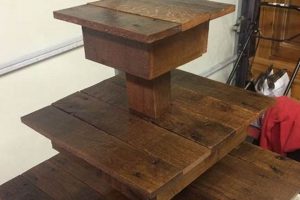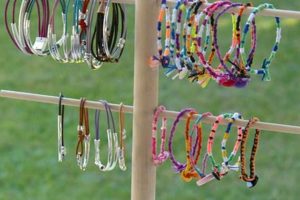A structure used to support backdrops for photography is typically comprised of vertical supports and a horizontal crossbar. It enables photographers and videographers to create controlled environments for capturing images and footage. These supports can be made from a variety of materials, including metal pipes, wood, or even repurposed items, allowing for adjustable height and width to accommodate different backdrop sizes.
Utilizing such a support offers significant advantages in terms of cost savings and customization. Ready-made commercial options can be expensive; constructing a support independently provides a budget-friendly alternative. Furthermore, this approach allows for tailored designs that specifically meet the user’s needs, such as adapting the structure to fit unique space constraints or incorporating specific materials to match a particular aesthetic. The ability to create a bespoke solution enhances creative control over the final photographic or video output.
The subsequent sections will delve into the various materials and construction techniques applicable for crafting these photographic support structures. Discussions will encompass the selection of appropriate materials, step-by-step assembly guides, and essential safety considerations throughout the building process.
Construction Advisories
The following represent key considerations for constructing a support structure intended to hold photographic backdrops. These recommendations aim to ensure stability, safety, and optimal performance of the completed structure.
Tip 1: Material Selection. Prioritize durable materials suitable for the anticipated load. Metal pipes, such as galvanized steel, offer strength and longevity. Wood provides a cost-effective alternative, but requires careful selection to avoid warping or breakage. Consider the backdrop’s weight and dimensions when determining material strength.
Tip 2: Stability is Paramount. Design the base to provide a wide, stable footprint. Weighted bases or tripods offer superior stability, particularly when using heavier backdrops or working outdoors. Ensure the base is level to prevent tilting or collapse.
Tip 3: Secure Connections. Use robust connectors to join sections of the structure. Clamps, screws, or welding provide secure connections. Regularly inspect connections for signs of loosening or wear to prevent structural failure.
Tip 4: Adjustable Height. Incorporate adjustable height mechanisms to accommodate different backdrop sizes and shooting angles. Telescoping poles or adjustable clamps provide flexibility in height adjustment.
Tip 5: Weight Distribution. Distribute the backdrop’s weight evenly across the crossbar. Use multiple clamps or clips to secure the backdrop at regular intervals. Avoid overloading any single point, which can cause stress and potential collapse.
Tip 6: Safety Precautions. Always work in a clear, well-lit area. Use appropriate safety equipment, such as gloves and eye protection, during construction. Be aware of potential hazards, such as sharp edges or pinch points.
Tip 7: Consider Portability. If portability is a requirement, design the structure to be easily disassembled and transported. Use lightweight materials and quick-release connectors to facilitate assembly and disassembly.
Implementing these suggestions contributes to a safe, reliable, and versatile support system for photographic backdrops. Adherence to these principles ensures a durable and functional structure capable of meeting various photographic needs.
The subsequent section will address common troubleshooting issues encountered during construction and usage, offering potential solutions and preventative measures.
1. Stability
Stability represents a critical attribute in the context of independently constructed photographic backdrop supports. A stable structure ensures consistent backdrop positioning, preventing unwanted movement that could compromise image quality or pose safety risks during operation.
- Base Design and Weight Distribution
The foundation of a backdrop support significantly influences its stability. A wider base offers greater resistance to tipping, while strategically placed weights can further enhance equilibrium, especially when using heavier backdrops. Uneven weight distribution or an inadequately sized base can lead to instability, resulting in a compromised photographic setup.
- Material Rigidity and Connection Strength
The materials used in construction and the integrity of the connections between structural components play a vital role. Flexible materials, such as thin-walled PVC, may introduce unwanted sway or bending, compromising stability. Weak or improperly secured connections between the vertical supports and crossbar can lead to structural failure and collapse.
- Environmental Factors and Load Capacity
External factors, such as wind or uneven surfaces, can adversely affect stability. The stand’s load capacity, referring to the maximum weight it can safely support, must be carefully considered in relation to the backdrop’s weight and any additional accessories. Exceeding the load capacity or failing to account for environmental conditions can lead to instability and potential hazards.
- Adjustability Mechanisms and Locking Systems
Features like adjustable height are useful, but they introduce points of potential weakness. If the mechanisms are not secure and well-designed, stability can be compromised. Reliable locking systems are essential to maintain the desired height without slippage or instability. The quality and functionality of these adjustable components play a significant role in the overall stability of the DIY photographic backdrop support.
The aspects described above highlight the integral role that stability plays in the effective operation of a independently assembled backdrop support. Prioritizing stability through careful design, material selection, and construction techniques ensures a safe and reliable platform for creating high-quality photographic and video content.
2. Adjustability
Adjustability represents a crucial functional characteristic in independently constructed photographic backdrop supports. The capacity to modify dimensions and features accommodates diverse photographic requirements and spatial limitations, augmenting the versatility and utility of such a structure.
- Height Variability
The ability to alter the vertical dimension of the backdrop support addresses varying subject sizes and compositional needs. For instance, portrait photography typically necessitates a lower backdrop height compared to full-body shots or group photographs. Telescoping poles or sectional designs facilitate height adjustments, enabling adaptation to different shooting scenarios.
- Width Adaptability
Modifying the horizontal dimension of the support accommodates backdrops of differing widths and spatial constraints. A narrower width may be suitable for small studios or confined spaces, while a wider setup is advantageous for larger backdrops or group shots. Modular crossbars or adjustable extension mechanisms provide width adaptability, optimizing the setup for specific photographic needs.
- Backdrop Mounting Options
Versatility in mounting mechanisms accommodates various backdrop materials and attachment methods. Clamps, clips, or integrated mounting systems enable the secure attachment of fabric, paper, or vinyl backdrops. Adaptable mounting options ensure compatibility with diverse backdrop types, expanding the creative possibilities within a photographic setting.
- Angle and Tilt Adjustments
The capacity to modify the angle or tilt of the backdrop provides nuanced control over lighting and background aesthetics. Tilting the backdrop can influence light reflection, shadow placement, and overall visual effect. Adjustable joints or rotating mechanisms enable angle and tilt adjustments, facilitating creative control over the photographic environment.
Collectively, these facets of adjustability augment the functional value of self-assembled backdrop supports. Height and width variability accommodate diverse subject sizes and spatial constraints, while versatile mounting options ensure compatibility with diverse backdrop materials. The capacity to modify angle and tilt provides refined control over lighting and background aesthetics. These adjustable attributes collectively empower photographers with the flexibility required to adapt to diverse shooting scenarios and achieve desired visual outcomes.
3. Portability
Portability exerts a significant influence on the utility of self-constructed photographic backdrop supports, particularly for photographers who operate in diverse locations or require flexible studio setups. The design and material choices directly impact the ease with which a stand can be transported and reassembled. A heavy, bulky stand constructed from rigid materials limits its usability to fixed locations, whereas a lightweight, collapsible design expands its application to on-location shoots, event photography, and studios with limited storage space. For example, a photographer specializing in outdoor portraits would benefit greatly from a portable stand, allowing them to set up quickly at various scenic locations, thus increasing their service offerings and client convenience.
The relationship between portability and the overall practicality of a stand centers on balancing weight, size, and structural integrity. Choosing lightweight materials such as aluminum or PVC, combined with a modular design that allows for disassembly into smaller components, can significantly enhance portability without compromising stability. However, focusing solely on weight reduction may lead to a structurally weak stand that cannot support heavier backdrops or withstand windy conditions. A well-engineered, portable stand must therefore incorporate robust connectors and a stable base design to ensure both ease of transport and reliable performance in various environments. This principle guides the selection of materials and structural designs.
Ultimately, the value of portability in independently assembled backdrop supports lies in its ability to broaden photographic opportunities and enhance workflow efficiency. By prioritizing portability, photographers gain the freedom to create professional-quality images in diverse settings, without being constrained by bulky, immobile equipment. While challenges such as balancing weight, stability, and durability exist, a thorough understanding of the trade-offs involved allows for the construction of stands that effectively meet the specific needs of individual photographers and their photographic styles. The integration of portability into the design represents a key factor determining the practical effectiveness of these photographic tools.
4. Material Cost
Material cost represents a primary determinant in the feasibility and accessibility of constructing photographic backdrop supports independently. Budgetary considerations directly influence the selection of materials, complexity of the design, and overall practicality of the project. Optimization of material costs without compromising structural integrity and functionality is essential for maximizing value.
- Raw Material Prices
The price of raw materials, such as metal pipes, wood, PVC, and connectors, significantly impacts the overall project expenditure. Prices fluctuate based on market demand, availability, and supplier. Careful price comparison across different vendors and exploration of alternative materials can mitigate cost overruns. For example, utilizing reclaimed wood instead of purchasing new lumber reduces material costs while promoting sustainability.
- Tool and Equipment Requirements
Construction necessitates specific tools and equipment, including saws, drills, measuring instruments, and safety gear. If these items are not already available, their acquisition constitutes an additional cost. Renting tools or borrowing from acquaintances offers potential cost savings. Planning the project to minimize the need for specialized tools can also reduce the overall financial burden.
- Construction Complexity and Waste
Intricate designs require more materials and specialized skills, thereby increasing costs. Simpler designs, which minimize material waste and construction time, are generally more cost-effective. Accurate measurements and careful cutting techniques reduce material waste, further optimizing cost efficiency. For instance, designing a support that minimizes the need for complex joints reduces both material consumption and labor.
- Longevity and Durability
Investing in higher-quality, more durable materials may increase initial costs but potentially yields long-term savings by reducing the need for repairs or replacements. Materials resistant to wear, tear, and environmental factors offer greater longevity and minimize life-cycle costs. Balancing initial cost savings with long-term durability is crucial for achieving optimal value in independently constructed photographic backdrop supports. A stand made from galvanized steel might have a higher initial material cost than one made from PVC, but its increased durability and load capacity might make it more cost-effective in the long run.
Material cost optimization represents a critical consideration in independently constructed photographic backdrop supports. Strategic material selection, efficient construction practices, and consideration of long-term durability contribute to a cost-effective outcome, enabling photographers to create functional and versatile support structures within budgetary constraints. Balancing cost savings with performance and longevity ensures maximal value from the independently constructed backdrop support.
5. Ease Construction
The ease with which a photographic backdrop support can be constructed significantly influences its accessibility and appeal, particularly for individuals undertaking a do-it-yourself project. Factors governing construction difficulty impact the time investment, required skill set, and overall feasibility of creating a functional and reliable support structure. The simplicity of the design, availability of materials, and necessity of specialized tools are fundamental determinants of ease of construction.
- Simplicity of Design
A design characterized by minimal components and straightforward assembly processes enhances construction ease. Structures requiring intricate joints, complex cutting, or specialized welding techniques demand a higher level of skill and increase the likelihood of errors. Simple designs leveraging readily available connectors and pre-cut materials streamline the construction process and reduce potential complications. An example is a stand built using PVC pipes and slip-on fittings, which requires minimal cutting and no welding, contrasting with a welded steel frame requiring advanced fabrication skills.
- Material Availability and Accessibility
The ease of sourcing necessary materials directly affects construction ease. Materials readily available at local hardware stores or online retailers contribute to a smoother and more efficient building process. Conversely, materials requiring specialized orders, long lead times, or sourcing from distant suppliers increase the time and effort involved in construction. The universal availability of lumber, compared to specialized metal alloys, exemplifies this principle. The quicker and easier the materials are to obtain, the simpler the construction process becomes.
- Tool Requirements and Skill Level
The types of tools required and the level of skill needed to operate them significantly impact construction difficulty. Projects requiring basic hand tools, such as saws, screwdrivers, and measuring tapes, are more accessible to a wider range of individuals. Structures necessitating power tools, welding equipment, or specialized machinery demand additional training and experience, potentially increasing the barrier to entry. A support that can be assembled using only a screwdriver and a measuring tape is far easier to construct than one requiring welding equipment and advanced metalworking skills.
- Clarity of Instructions and Documentation
The availability of clear, concise, and well-illustrated instructions directly impacts the ease of construction. Detailed diagrams, step-by-step guides, and instructional videos minimize ambiguity and facilitate accurate assembly. Conversely, poorly documented or incomplete instructions can lead to confusion, errors, and increased construction time. The presence of readily available online tutorials and build guides significantly simplifies the process of creating a DIY photographic backdrop support, provided that the instructions are comprehensive and easy to follow.
The interplay between these aspects significantly determines the overall ease of construction for independent photographic backdrop supports. Designs that prioritize simplicity, utilize readily available materials, minimize the need for specialized tools, and are accompanied by clear instructions are more accessible to a broader range of individuals, enhancing the feasibility of creating cost-effective and functional photographic equipment.
6. Safety
The integration of safety considerations into the design and construction of independently built photographic backdrop supports is of paramount importance. Omission of safety protocols can lead to structural instability, posing significant risks of equipment damage and potential physical injury to individuals in the vicinity. The interplay between design choices, material selection, and construction techniques directly influences the safety profile of the resulting stand. For example, a stand constructed from improperly joined PVC pipes may appear functional but could collapse under the weight of a backdrop, leading to both equipment damage and potential harm.
Specific safety concerns manifest in several key areas. Load capacity, referring to the maximum weight the stand can safely support, requires careful consideration. Overloading the stand creates stress points, increasing the risk of structural failure. Secure connections between components, achieved through appropriate fastening methods, are essential for preventing collapse. Additionally, stability, influenced by base design and weight distribution, prevents accidental tipping, particularly in environments with uneven surfaces or strong winds. Implementation of safety measures such as weighted bases, robust connectors, and regular inspections mitigate these risks. The practical significance of understanding these risks is demonstrated by the reduction in accidents and equipment failures when proper safety procedures are followed.
In conclusion, safety constitutes an integral and non-negotiable component of the independently constructed photographic backdrop support. Adherence to established safety principles during design and construction phases reduces the likelihood of accidents, safeguards equipment, and minimizes potential physical harm. Consistent application of these practices ensures a stable, reliable, and secure environment for photographic activities, contributing to both enhanced creative output and risk mitigation. Challenges may arise in balancing safety considerations with cost and ease of construction; however, prioritizing safety remains the paramount objective.
DIY Photo Backdrop Stand FAQs
This section addresses frequently asked questions concerning the construction and utilization of photographic backdrop supports. The responses aim to provide clear and concise information for those undertaking such projects.
Question 1: What is the minimum weight capacity a DIY photo backdrop stand should possess to ensure safety and stability?
The minimum weight capacity varies depending on the type of backdrops used. However, a general recommendation is a minimum capacity of 10 pounds (4.5 kilograms) to accommodate common fabric and paper backdrops. For heavier materials, such as canvas or vinyl, a higher capacity of 20 pounds (9 kilograms) or more is advisable.
Question 2: Which materials offer the best balance of cost-effectiveness and durability for building a photo backdrop stand?
PVC pipes and fittings provide a cost-effective option for smaller, lightweight backdrops. Metal pipes, such as galvanized steel, offer increased durability and load capacity for larger or heavier setups. Wood can also be a viable option, but requires careful selection to ensure sufficient strength and resistance to warping.
Question 3: What is the optimal base design to maximize stability and prevent tipping of a DIY photo backdrop stand?
A wider base inherently provides greater stability. Tripod designs or weighted bases are recommended for enhanced stability, particularly when working with heavier backdrops or in environments prone to wind. Ensure the base is level to prevent imbalances.
Question 4: How can adjustability be incorporated into a DIY photo backdrop stand without compromising structural integrity?
Telescoping poles with secure locking mechanisms or adjustable clamps can facilitate height adjustments without sacrificing stability. Reinforce adjustable sections with additional supports or bracing to maintain structural integrity under load.
Question 5: What safety precautions should be observed during the construction and use of a DIY photo backdrop stand?
Wear appropriate safety gear, including eye protection and gloves, during construction. Ensure all connections are securely fastened and regularly inspected for signs of wear or loosening. Avoid overloading the stand beyond its rated weight capacity. Be mindful of potential tripping hazards posed by the base and support legs.
Question 6: How can portability be achieved in a DIY photo backdrop stand without sacrificing stability and ease of setup?
Utilize lightweight materials, such as aluminum or PVC, and design the stand to be easily disassembled into smaller components. Quick-release connectors or modular designs facilitate rapid assembly and disassembly. Prioritize a sturdy carrying case for safe transport.
Adherence to these guidelines ensures the creation of a safe, stable, and functional support structure for photographic backdrops. These considerations mitigate potential hazards and maximize the utility of independently constructed stands.
The next section will present detailed construction plans and diagrams for building various types of photographic backdrop supports.
Conclusion
This exploration of “diy photo backdrop stand” construction has outlined key considerations regarding stability, adjustability, portability, material cost, ease of construction, and safety. These elements are critical for a successful and functional outcome. Understanding these factors enables informed decisions in the design and building process.
The information presented provides a foundational understanding for creating customized photographic supports. Implementing these principles empowers individuals to construct cost-effective, safe, and versatile systems tailored to specific photographic requirements, thereby enhancing creative capabilities. Continued adherence to safety standards and best practices remains essential for ensuring long-term functionality and minimizing potential risks.







